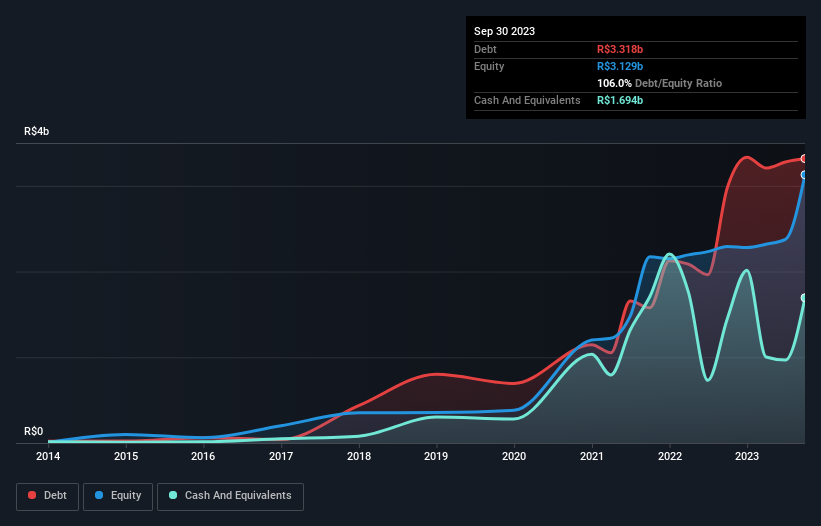- Brazil
- /
- Healthcare Services
- /
- BOVESPA:VVEO3
Here's Why CM Hospitalar S/A (BVMF:VVEO3) Has A Meaningful Debt Burden

The external fund manager backed by Berkshire Hathaway's Charlie Munger, Li Lu, makes no bones about it when he says 'The biggest investment risk is not the volatility of prices, but whether you will suffer a permanent loss of capital.' When we think about how risky a company is, we always like to look at its use of debt, since debt overload can lead to ruin. We can see that CM Hospitalar S/A (BVMF:VVEO3) does use debt in its business. But should shareholders be worried about its use of debt?
When Is Debt A Problem?
Debt and other liabilities become risky for a business when it cannot easily fulfill those obligations, either with free cash flow or by raising capital at an attractive price. If things get really bad, the lenders can take control of the business. However, a more frequent (but still costly) occurrence is where a company must issue shares at bargain-basement prices, permanently diluting shareholders, just to shore up its balance sheet. Of course, plenty of companies use debt to fund growth, without any negative consequences. When we think about a company's use of debt, we first look at cash and debt together.
Check out our latest analysis for CM Hospitalar S/A
How Much Debt Does CM Hospitalar S/A Carry?
The image below, which you can click on for greater detail, shows that at September 2023 CM Hospitalar S/A had debt of R$3.32b, up from R$2.98b in one year. However, it does have R$1.69b in cash offsetting this, leading to net debt of about R$1.62b.

How Strong Is CM Hospitalar S/A's Balance Sheet?
According to the last reported balance sheet, CM Hospitalar S/A had liabilities of R$2.93b due within 12 months, and liabilities of R$3.91b due beyond 12 months. Offsetting this, it had R$1.69b in cash and R$275.7m in receivables that were due within 12 months. So its liabilities outweigh the sum of its cash and (near-term) receivables by R$4.86b.
Given this deficit is actually higher than the company's market capitalization of R$4.07b, we think shareholders really should watch CM Hospitalar S/A's debt levels, like a parent watching their child ride a bike for the first time. In the scenario where the company had to clean up its balance sheet quickly, it seems likely shareholders would suffer extensive dilution.
We measure a company's debt load relative to its earnings power by looking at its net debt divided by its earnings before interest, tax, depreciation, and amortization (EBITDA) and by calculating how easily its earnings before interest and tax (EBIT) cover its interest expense (interest cover). Thus we consider debt relative to earnings both with and without depreciation and amortization expenses.
While CM Hospitalar S/A has a quite reasonable net debt to EBITDA multiple of 2.0, its interest cover seems weak, at 1.9. This does suggest the company is paying fairly high interest rates. In any case, it's safe to say the company has meaningful debt. It is well worth noting that CM Hospitalar S/A's EBIT shot up like bamboo after rain, gaining 32% in the last twelve months. That'll make it easier to manage its debt. There's no doubt that we learn most about debt from the balance sheet. But ultimately the future profitability of the business will decide if CM Hospitalar S/A can strengthen its balance sheet over time. So if you're focused on the future you can check out this free report showing analyst profit forecasts.
Finally, while the tax-man may adore accounting profits, lenders only accept cold hard cash. So the logical step is to look at the proportion of that EBIT that is matched by actual free cash flow. In the last three years, CM Hospitalar S/A created free cash flow amounting to 6.5% of its EBIT, an uninspiring performance. That limp level of cash conversion undermines its ability to manage and pay down debt.
Our View
To be frank both CM Hospitalar S/A's level of total liabilities and its track record of covering its interest expense with its EBIT make us rather uncomfortable with its debt levels. But at least it's pretty decent at growing its EBIT; that's encouraging. It's also worth noting that CM Hospitalar S/A is in the Healthcare industry, which is often considered to be quite defensive. Once we consider all the factors above, together, it seems to us that CM Hospitalar S/A's debt is making it a bit risky. That's not necessarily a bad thing, but we'd generally feel more comfortable with less leverage. The balance sheet is clearly the area to focus on when you are analysing debt. But ultimately, every company can contain risks that exist outside of the balance sheet. To that end, you should learn about the 4 warning signs we've spotted with CM Hospitalar S/A (including 1 which is concerning) .
If you're interested in investing in businesses that can grow profits without the burden of debt, then check out this free list of growing businesses that have net cash on the balance sheet.
New: AI Stock Screener & Alerts
Our new AI Stock Screener scans the market every day to uncover opportunities.
• Dividend Powerhouses (3%+ Yield)
• Undervalued Small Caps with Insider Buying
• High growth Tech and AI Companies
Or build your own from over 50 metrics.
Have feedback on this article? Concerned about the content? Get in touch with us directly. Alternatively, email editorial-team (at) simplywallst.com.
This article by Simply Wall St is general in nature. We provide commentary based on historical data and analyst forecasts only using an unbiased methodology and our articles are not intended to be financial advice. It does not constitute a recommendation to buy or sell any stock, and does not take account of your objectives, or your financial situation. We aim to bring you long-term focused analysis driven by fundamental data. Note that our analysis may not factor in the latest price-sensitive company announcements or qualitative material. Simply Wall St has no position in any stocks mentioned.
About BOVESPA:VVEO3
CM Hospitalar S/A
Engages in the distribution of hospital materials, medicines, and nutrition products in Brazil.
Undervalued low.
Market Insights
Community Narratives




